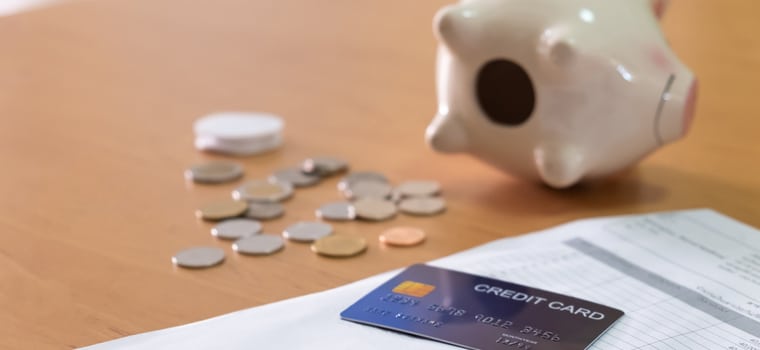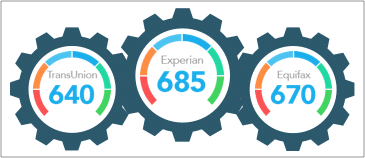Credit card companies charge interest on any balance that you don’t pay off at the end of a statement period. The interest is a charge that you pay for using the credit card company’s money. If you fail to pay off your entire balance on or before the due date, the unpaid portion of the balance will be carried over to the next statement period. It will not be considered late, as long as you make at least the specified minimum payment, but you will be charged interest on it.
Credit cards charge higher interest rates than most loans, but if you manage your credit card spending and payments effectively you may not have to pay any interest at all. If you pay your balance in full before the due date each month you will pay no interest, unless you use your card for cash advances.
Credit card interest can accumulate very quickly and understanding how that happens and how credit card interest works can help you avoid the credit card debt trap.
Interest Rate and APR: Are They the Same Thing?
Interest is the price that you pay for the use of somebody else’s money. You can think of a loan as renting money, and the interest as the rental cost. Interest is usually a percentage of the sum that is borrowed, but it can be computed in many different ways.
When credit card companies discuss interest rates, they usually refer to an APR, or annual percentage rate. The APR describes the cost of borrowing on an annual basis. The APR allows you to compare the interest costs of different cards directly.
It’s easy to get confused by the difference between the APR of an installment loan and the APR of a credit card. The APR of an installment loan, like a personal loan or a car loan, includes interest, fees, and any other loan costs. It indicates the total cost of the loan.
Credit cards and other forms of revolving credit use the term “APR” differently. The APR of a credit card is essentially the same as the interest rate and does not include fees or other costs. In fact, the Truth in Lending act requires credit card companies to express their interest rates as APR. When a credit card company describes your interest rate, they will almost always refer to it as the APR. This figure does not include fees and you should assess those separately.
How Does a Credit Card Issuer Set My Interest Rate?
Different people may pay very different interest rates for the same credit card. You will often see a card’s interest rate expressed as a range, for example from 13% to 23%.
The credit card issuer bases your interest rate on their assessment of the risk involved in lending to you. The higher the risk, the higher your interest rate will be. The assessment of risk is primarily based on your credit score. If your credit is good you will get a relatively low APR. If your credit is less good your APR will be higher.
Credit card issuers can change your APR with 45 days’ notice and can raise the rate on your existing balance with 60 days’ notice.
The average lowest available APR of new American credit card offers in the first quarter of 2020 is 17.49%. Cardholders with lower credit are being offered APRs up to 26.49%.
A credit card APR may be fixed or variable. A fixed APR is permanently set, a variable APR may change as market interest rates fluctuate. Almost all credit cards have variable APRs. Your card issuer will notify you of changes in your APR.
Your Card Has More Than One Interest Rate
Each credit card has several APRs, which can make comparisons difficult. These are some of the common APR types that may be used in computing your interest.
- An Introductory or promotional APR is a lower rate, sometimes zero interest, that is offered to new cardholders. Always check the rate that will apply after the promotional period is over, and always note when the promotion will end.
- A purchase APR is applied to purchases made with your credit card.
- A balance transfer APR is applied to balances that you transfer from other cards.
- A cash advance APR is applied to cash advances taken out on your credit card. It is typically higher than a purchase APR.
- A penalty APR is a higher interest rate imposed as a penalty for a violation of the credit card agreement, usually after a late or missed payment.
Your credit card agreement should contain a table clearly stating all APRs and fees for your card. If you are familiar with the different APRs and when they are assessed, it will be easier to control your spending on credit card interest.
When you pay your credit card bill, the issuer is required to apply anything above the minimum payment to the balance with the highest interest rate. If you are only making the minimum payment, they can apply your payment to the balance with the lowest rate and leave the higher-interest balances untouched. That’s a good reason to make more than the minimum payment!
How Is Credit Card Interest Calculated?
As long as you make the minimum payment on your credit card bill, your payment will not be considered late. Your issuer will, however, begin charging interest on that unpaid balance after the due date.
Your interest will be based on your average daily balance through the duration of the billing cycle. This will include purchases you make during that billing cycle. The interest on a balance you carry beyond the due date is computed on a daily basis. To calculate the daily interest rate, divide your APR by 365.
Credit card interest is also compounded daily. Your interest is added to your balance on one day and the next day you’ll pay interest on the total, including the interest you incurred yesterday. Because you are paying interest on your interest, credit card interest can spiral out of control very quickly, especially if you continue to make purchases and add to your balance.
If you miss payments or make late payments, you may trigger a higher penalty APR. That can make a high balance even harder to pay off.
How to Avoid Paying Credit Card Interest
Most credit card issuers charge no interest on purchases if you pay your balance in full on or before the due date. The period of time between the statement closing date and the payment due date is called a grace period.
Credit card issuers that give a grace period are required to give you at least 21 days after your statement closing date before they begin charging interest. As long as you pay your balance in full before the end of the grace period, you will pay no interest on your purchases during that statement period.
The grace period usually applies only to purchases made during the statement period, not to cash advances or balance transfers.
Paying your balance in full before the due date every month is the simplest way to avoid credit card interest. There are several other steps that can help you minimize your interest costs.
- Use a zero-APR introductory rate. Many credit cards will give new cardholders a promotional 0% APR period. Purchases made during this period will be free of interest as long as the balance is paid in full at the end of the promotional period. This may not apply to cash advances, and in some cases late or missed payments may cancel the promotion. Be sure to keep track of when the promotion ends!
- Avoid making the minimum payment. Card issuers will allow you to pay only a very small percentage of your balance as a minimum payment. That may avoid late payment penalties, but you will carry a large balance to the next statement period, and you will pay interest on that balance.
- Avoid cash advances. They usually carry a higher APR than purchases, and they are usually not included in your grace period. They begin accruing interest as soon as you draw the money.
- Manage your spending. The key to paying no interest on your credit card purchases is to pay your balance in full every month. You can’t do that if you spend more than you can afford to pay.
These are not complicated steps, but they aren’t always easy, which is why American cardholders who carry a balance from month to month averaged $1,162 per year in interest payments in 2019. You don’t have to be average, and if you manage your cards effectively, you don’t have to pay interest!
Your Credit Card Can be Expensive, Or Almost Free!
Credit card debt is a major burden for millions of Americans. Total US credit card debt broke the $1 trillion mark in late 2019, an average of over $8,500 per American household. Because credit card debt carries such high-interest rates, that level of debt creates a serious problem for many people.
That’s a grim picture, but there’s also good news: you don’t have to pay interest on your credit card at all. If you avoid cash advances and pay your balance in full before the due date every month you will not pay any interest on your card.
Keeping your credit card interest-free is not easy, but if you budget carefully, manage your spending, and understand how credit card interest works it can be done. The reward is freedom from high-interest credit card debt!




